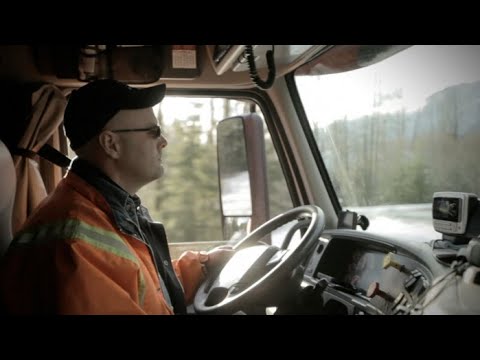Career Overview
Transport truck drivers operate heavy trucks to transport goods and materials over urban, interurban, provincial and international routes. This unit group also includes drivers of special purpose trucks and shunters who move trailers to and from loading docks within trucking yards or lots.
People in this occupation:
- Work for trucking, transportation and manufacturing companies
- May be self-employed
- Must have excellent driving skills, good judgment, an ability to remain focused for extended periods of time and to react quickly in emergency situations
- Should enjoy meeting new people as well as working alone and should have good time-management and organizational abilities
- Are expected to be aware of various regulations governing truck transportation, including record-keeping requirements, weights and dimensions regulations and acceptable routing
Job Titles
Duties
Long-haul transport truck drivers perform some or all of the following duties:
- Operate and drive primarily tractor-trailor, long-combination vehicle and straight-body trucks weighing over 4500 kg to transport goods and materials over long distances
- Plan trip logistics and obtain required documentation to transport goods
- Perform pre-trip, en route and post-trip inspection of vehicle systems, equipment and accessories such as tires, lights and turning signals, brakes and cold storage
- Ensure cargo is secured properly in accordance with safety requirements and follow safety procedures for transporting dangerous goods
- Obtain special permits and other documents required to transport cargo on international routes
- Record cargo information, hours of service, distance travelled and fuel consumption
- Administer bills of lading and manually or electronically maintain log books
- Communicate with dispatcher, other drivers and customers using communication devices and on-board computers
- May perform emergency roadside repairs
- May drive as part of a two-person team or convoy
- May transport hazardous products or dangerous goods
Short-haul and local transport truck drivers perform some or all of the following duties:
- Operate and drive primarily straight trucks to transport goods and materials mainly on local routes and short inter-urban routes
- Perform pre-trip, en route and post-trip inspection and oversee all aspects of vehicle such as condition of equipment, and loading and unloading of cargo
- May drive special purpose trucks such as tow trucks, dump trucks, hydrovac trucks or cement mixing trucks
Earnings
Earnings is income that workers receive in exchange for their labour. Depending on the type of employment, earnings can be in the form of wages (hourly), salaries (fixed monthly or annual) or self-employed earnings.
Work Environment
# Workers Employed
41,350% Employed Full Time
57%Working conditions for long-haul truck drivers and local truck drivers differ to some degree. Local truck drivers typically make many deliveries throughout the day. Because they serve local businesses, their hours are mostly dictated by regular business hours.
Long-haul drivers move goods between cities and across the continent. They often drive throughout the night when traffic is low, for shifts up to, but not exceeding, 14 hours. Schedules may also be flexible. Because long-haul drivers can spend a significant time away from home, many trucks are equipped with "sleeper" cabs and modern amenities, such as TVs, microwaves and computers.
Truck drivers spend most of their time driving and sitting in seats that are generally comfortable. However, it is not uncommon for drivers to develop back or neck injuries from sitting for long periods of time or from loading and unloading cargo.
Most truck drivers work alone. Some long-haul drivers may drive with a co-worker and rotate shifts.
Career Pathways
Truck drivers can progress to the control of heavier equipment by upgrading their licences.
Advancement into supervisory or management positions, or into non-driving occupations such as dispatcher, safety officer or driving trainer, is possible with additional training or experience.
Occupational Interests
It’s important to understand what kinds of occupations align with your interests.
For more about occupational interests visit Skills for the Future Workforce > Characteristics.
Here are the top occupational interest(s) for this career profile:
Education, Training and Skills
There is currently no minimum training standard for truck drivers, however, this may change in the next few years, as the industry has recognized a need for one. Employers typically establish their own standards for hiring and may require a minimum of a secondary school level education, some previous experience, or completion of driver training. Some employers provide on-the-job training. Other requirements include:
- A Class 3 commercial licence to operate vehicles with more than two axles, which includes smaller commercial vehicles such as tow trucks and dump trucks
- A Class 1 driver's licence for trucks with semi-trailers
- An air brake endorsement to operate a truck with air brakes
Drivers must be at least 18 years of age to obtain a Class 3 licence, and at least 19 to obtain a Class 1 licence. All drivers must also meet required medical standards before receiving a licence. Vision, hearing and physical and medical conditions are screened prior to licensing.
Drivers making deliveries to the United States must be at least 21 years of age, pass a standard drug test, and participate in an on-going random drug and alcohol testing program. Other qualifications that are beneficial to drivers:
- A good driving record and no criminal history, particularly as security screening for truck drivers increases
- The ability to read and write English fluently
- Transportation of Dangerous Goods certification for drivers who transport hazardous products or dangerous goods
Many British Columbia colleges and private institutions offer truck driver training programs. Standard programs are typically three to four weeks in length, but programs offering more extensive training can last from 12 to 14 weeks.
For more information about the Canadian trucking industry, visit TruckingHR Canada at https://truckinghr.com
Education programs in B.C.

Top Skills
Every job calls for a certain set of skills. Knowing those skills is the first step in finding a good career fit.
Here, you will find the 10 most relevant workplace skills. Some are more important to achieving success in a certain career than others. These skills may come naturally to you or you may need to gain them through education, training and experience.
See the list of work-related skills below, ranked in order of importance for this career. Check out the list and see if this career matches your skills—take that first step!
Controlling operations of equipment or systems.
Watching gauges, dials or other indicators to make sure that a machine is working properly.
Keeping track of and assessing your performance, other individuals, or organizations to make improvements or take corrective action.
Understanding written sentences and paragraphs in work-related documents.
Managing one’s own time and the time of others.
Using logic and reasoning to identify the strengths and weaknesses of alternative solutions, conclusions or approaches to problems.
Talking to others to share information effectively.
Determining causes of operating errors and deciding what to do about it.
Giving full attention to what other people are saying, taking time to understand the points being made, asking questions as appropriate, and not interrupting at inappropriate times.
Performing routine maintenance on equipment and determining when and what kind of maintenance is needed.
Labour Market Statistics
Discover data, facts and information that have been gathered and analyzed. Learn about the characteristics of the economy and labour market in B.C.
Employment
Find out about employment types and trends by region and industry.
Employment
41,350Employment by Region







| Region | Employment | % Employment of this Occupation |
|---|---|---|
| Cariboo | 2,340 | 5.7% |
| Kootenay | 1,725 | 4.2% |
| Mainland/Southwest | 25,290 | 61.2% |
| North Coast and Nechako | 1,185 | 2.9% |
| Northeast | 1,540 | 3.7% |
| Thompson-Okanagan | 4,775 | 11.5% |
| Vancouver Island/Coast | 4,500 | 10.9% |
Labour Market Outlook
The B.C. Labour Market Outlook is a 10-year forecast of the expected supply and demand for labour in the province. It’s usually updated every year. The purpose is to provide British Columbians with the knowledge to make informed decisions on careers, skills training, education and hiring.
Forecasted Job Openings (2025-2035)
15,350Forecasted Job Openings
Forecasted Employment Growth Rate
Composition of Job Openings
Job Openings by Region (2025-2035)







| Region | Job Openings | Avg. Annual Employment Growth |
|---|---|---|
| Cariboo | 700 | 0.0% |
| Kootenay | 780 | 0.1% |
| Mainland/Southwest | 8,590 | 0.8% |
| North Coast and Nechako | 660 | 0.4% |
| Northeast | 600 | 0.3% |
| Thompson-Okanagan | 2,140 | 0.6% |
| Vancouver Island/Coast | 1,900 | 0.6% |
Industry Highlights
Learn about the opportunities in B.C.'s major industries, including employment trends, earning potential, locations of work and more.
Forecasted Job Openings by Industry
| Industry | Job Openings (2025-2035) |
|---|---|
| Transportation and Warehousing | 8,940 |
| Construction | 1,310 |
| Mining and Oil and Gas Extraction | 850 |
| Wholesale Trade | 810 |
| Retail Trade | 570 |
Insights from Industry
Since this is a large occupational group, a significant number of openings are expected. New openings will result from growth in the Transportation and Warehousing industry.
Many additional openings will result from a high rate of worker turnover, especially in entry-level service sector positions, such as food delivery.
Industry sources report a current sufficient supply of qualified truck drivers, but expect this to change as the economy improves.
Resources
-
B.C. Ministry of Transportation and Infrastructurewww2.gov.bc.ca/gov/content/governments/organizational-structure/ministries-organizations/ministries/transportation-and-infrastructure
-
BC Trucking Association (BCTA)www.bctrucking.com
-
British Columbia Trucking Association – Job Postingswww.bctrucking.com/careers/job-postings
-
Insurance Corporation of British Columbia (ICBC)www.icbc.com
-
Professional Truck Driver Trainingwww.bctrucking.com/training
-
Rules of the Road in B.C. – RoadSafetyBCwww2.gov.bc.ca/gov/content/transportation/driving-and-cycling/roadsafetybc
-
TranBC, Ministry of Transportation and Infrastructurewww.tranbc.ca
-
WorkSafeBCwww.worksafebc.com








